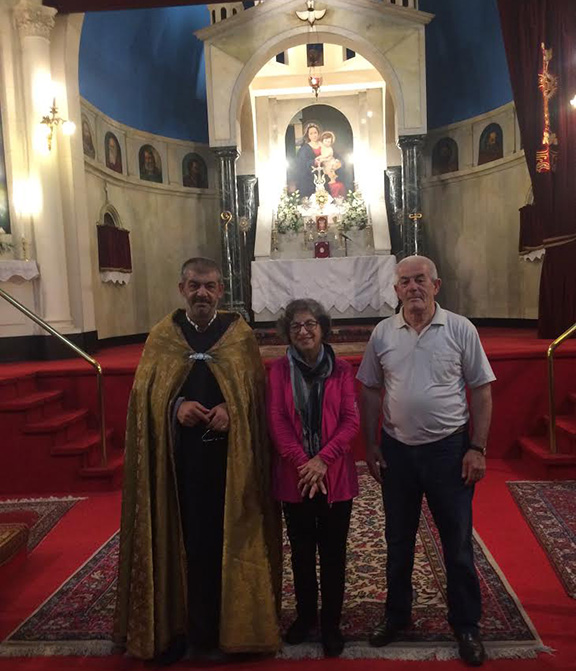BY CATHERINE YESAYAN
Let’s take a look at what my first day in Buenos Aires was like.
A few months ago, as I did a search to find a place to stay in Buenos Aires, a room caught my eye. Its address was a block away from “Armenia” Street. I quickly made the reservation.
When I arrived at Buenos Aires airport, I took a shuttle from the airport to the bus terminal, and from there a taxi to my apartment. On the way, the taxi driver told me, of course in Spanish, “Your apartment is smack in the midst of the Armenian quarters.”
The next day, I headed to Armenia Street, only a short block away. As I entered the street, I was delighted to see so many Armenian organizations lining both sides of the street—school, church, cultural center, stores, real estate offices, etc. However, as it was Saturday, the 24th of December, all were closed.
It gave me goosebumps to see all the signs in Armenian language. I felt like a kid in a candy store. I had never seen, outside of Armenia, such a centralized spot all Armenian.
My reason to come to Buenos Aires was to write about the Armenian community, and here I was, surrounded by everything Armenian. On the store fronts there were many tricolor flags (blue-red-orange) and also many Forget-Me-Not purple flowers, in memory of Armenian Genocide.
As I was stunned by what I was seeing, I came across three people at a table on the sidewalk. They didn’t look Armenian at all. So I asked in Spanish if they knew an Armenian restaurant around there. The guy in the middle asked me if I could speak in Armenian. I said, “Sí, puedo hablar en Armenio.” (Yes, I can speak in Armenian). And he started to answer my question in Armenian. His name was Mauricio.
At first, I didn’t see the books on display were in Armenian language. Soon I realized that they were Jehovah’s Witnesses promoting their religion. I interviewed Mauricio and recorded it on my phone and post it on my Facebook. I found it very interesting. He was speaking a very good Armenian.
Me: When did you learn Armenian?
Mauricio: When I was 11 years old. (Now he’s 21)
Me: Can you also read in Armenian?
Mauricio: Yes, I can read. (He points to the Armenian Bible in his hand.)
Mauricio invited me to come back at 5 pm to listen to a live broadcast from Armenia. When I went back around 5, Mauricio ushered me into a small room inside of the building. There were about a dozen Armenians. I said hello to everybody, and they came and gave me a hug.
Before the session began, I briefly talked to a young married couple in their twenties—Lillit and her husband Edgar Antonian. They had moved from Armenia two years ago and had become active in the Jehovah’s church. Edgar had become a Jehovah Witness about four years ago, but Lillit’s parents in Armenia belonged to the church.
Another young guy, not Mauricio, spoke to us in Armenian about the agenda. We sang a song, and then the TV broadcast began. Since Buenos Aires is in the Southern Hemisphere, December 24th falls in the middle of summer. The air-conditioning was turned up high, and the room was very cold. I couldn’t stay to the end of the broadcast. I excused myself and left.
Across from where Mauricio and his friends had set up a table, there was the Armenian Apostolic Church. I crossed the street to go to the church that like almost every building in Buenos Aires, was surrounded by security gates.
As I was speaking to the guard, I saw an elderly guy with grocery bags approaching us. I struck up a conversation with him.
He was Bagrad Nazarian, who in 1971, had moved his family from Narmak in Tehran to Armenia. His two sons, who graduated from the Seminary of Echmiadzin in Armenia, now both are serving as priests in two different churches in Buenos Aires.
Bagrad said, “First, my older son was ordained as a priest, and he was sent to serve in Argentina. Then my younger son was sent to Argentina, so 20 years ago, our whole family moved here.” He pointed to where they lived in two condominiums in the building across the street.
He told me that the next day, Sunday, there would be a regular mass at the church. He invited me to go to the church, where Der Yeghishe, his elder son, would conduct the mass.
After I met Bagrad, I strolled around the “Bario” (neighborhood) for a while to find an Armenian restaurant, but because it was Christmas Eve, no Armenian restaurants were open.
Finally, I came across a nice hamburger joint and enjoyed the tastiest burger I’ve ever eaten. I paid 180 pesos, about $12
Afterwards, I wound my way home to get ready to go to the special Christmas Eve Mass at the Armenian Catholic Church.
To be continued…
Source: Asbarez
Link: Arriving in Buenos Aires



